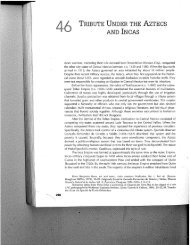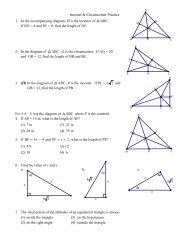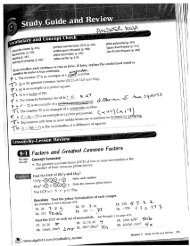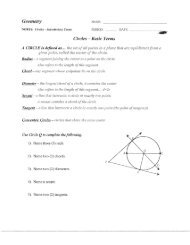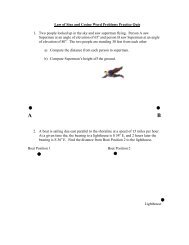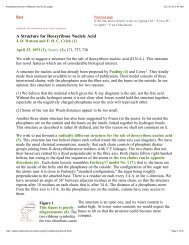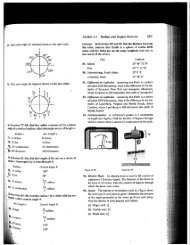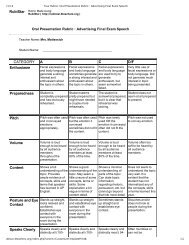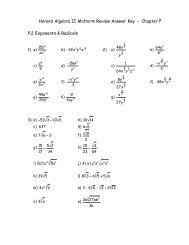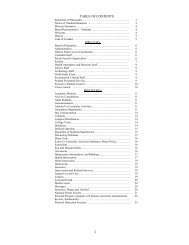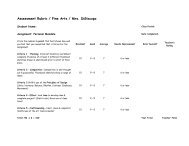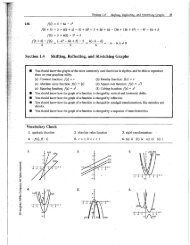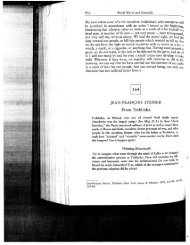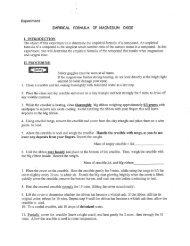You also want an ePaper? Increase the reach of your titles
YUMPU automatically turns print PDFs into web optimized ePapers that Google loves.
Name:<br />
Due Date:<br />
<strong>Magnetic</strong> <strong>Field</strong> <strong>and</strong> <strong>Flux</strong> <strong>AP</strong> <strong>Problem</strong><br />
P2~ 0 w 2w 3~ 4~" 5w<br />
(Continued on next page)
~oz~ e~_e of ~e |~ ~ ~e~ ~ :E~ Label al~o~t e x~al~es on ~ "~cal a~i~.<br />
0 w 2w 3~, 4w 5w<br />
Cum~nt<br />
....... -I ..... -q ....... I- ...... I- ...... ~---<br />
~ ...... -]" 1 ’I F .......<br />
T---<br />
I I I I I<br />
Clvckwisc<br />
Currant
Name:<br />
Due Date:<br />
Electromagnetism <strong>AP</strong> <strong>Problem</strong><br />
× X X X X<br />
×<br />
×<br />
×<br />
, East
Name:<br />
y<br />
Motional emf <strong>AP</strong> <strong>Problem</strong><br />
View from above<br />
Due Date:<br />
X "= O<br />
A r~l gun is a de~4ce dial propels aprojectile using a magnetic force, A si~lified diagrmn of ttfis device is<br />
shown above. The proje~fe in the picture is a ~m’ of mass M <strong>and</strong> length D, which has a cortstant curt’eat 1<br />
flowing throuNl it in the +.y-dlrecdon, as sho,a~a. The space between the thin frictionless rails contains a uNform<br />
magnetic field B, peipendicular to the plane of the page. The magnetic field <strong>and</strong>rails extend for a distance<br />
The magnetic field exerts a constant force F on the p~oject’~le, as<br />
Express all algebraic answers to the following parts in terms of the magnitude F of die constant magnetic fo~.ce,<br />
other quantities givegi above, <strong>and</strong> fundamental con~tants.<br />
(a) Determine the position x of the projectile as a function of time t Mille it is on the rail if the projectile starts<br />
from rest at x = 0 when t = 0,<br />
(b) Dctemfine the speed of the projectile as it leaves the right-h<strong>and</strong> end of the track.<br />
(c) Det~mine the energy supplied to the projectile by the rail gun.<br />
(d) In what direction must the magnetic field B point in order to create t_he force F Explain your reasoning.<br />
(e) Calculate the ,*pe~ of the bar when it reache.~ the erM of the tall gi’~’ea the following values.<br />
B=5T L=10m I=200A M=0.5 kg D= 10era
Name:<br />
Due Date:<br />
g (into page)<br />
X<br />
x × x J ×<br />
I 0,20 m<br />
x ~x xl x<br />
,---0.20 m-~<br />
A squat~ loop of wire of side 0.20 m has a torn reMstance of 0~ ~, ~e l~p is positioned in a uNfo~<br />
mag~tie field B ~" 0,030 T. ~e field is dtreOed into t~ pag~ p~pendi~la m the plane 6fthe Ioop~ as<br />
(a) Caleulalelhe m~nefie flux O tN’ough ~e<br />
~e fidd s~ng~ now in~e~s~ uNf~mly to 0.~ T in 0.50 s.<br />
(b) Calculate the emf &* indue~ in the loop dt~i~ N this<br />
L Cal~:late ~e m~Ntude I oflhe c~rent in ~e I~p during ~s ~ri~<br />
iL What is the Nrmtion of~e mnent in the laop<br />
Cloc~dse<br />
C~nterclo~wise<br />
Justi~ }~ ~swer.<br />
(d) Descfi~ a me~od by Milch you c~ld i~uce a c~nt in t~e loop if t~ magnetic field remain~
Due Date:<br />
Electromagnetic Induction <strong>AP</strong> <strong>Problem</strong><br />
Position I Position 2<br />
o o<br />
B out of page<br />
B equal to zero<br />
A 20-turn wire coil in the shape of a rectangle, 0.25 In by 0.15 In, has a resistance of 5.0 ~). In position 1 shown<br />
above,-the.loop is in a uniform magnetic field B of 0.20 T. The field is directed out of the page, perpendicular to<br />
the plane of the loop. The loop is pulled to the right at a constant velocity, reaching position 2 in 0.50 s. xvhere B<br />
is equal to zero.<br />
(a) Calculate the average emf induced in the 20-turn coil during this period.<br />
(b) Calculate the Inagnitude of the current induced in the 20-turn coil an~d state its direction.<br />
(c) Calculate the power dissipated in the 20-turn coil.<br />
(d) Calculate the Inagnitude of the average force necessary to reinove the 20-turn coil fmin the Inagnetic field.<br />
(e) Identical wire is used to add 20 Inore turns of wire to the original coil. How does this affect the current in<br />
the coil Justify yottr answer.
Name:<br />
Due Date:<br />
Electromagnetism <strong>AP</strong> <strong>Problem</strong><br />
Tap view
Name:<br />
Due Date:<br />
Electromagnetism <strong>AP</strong> <strong>Problem</strong><br />
Region ~ Region 11<br />
Particle x x<br />
x x x x<br />
A beara of particles of charge q = -~:3.2 x t0 -t~ C <strong>and</strong>mass m = 6,68 x lO -u~ kg enters region I with a range<br />
of velocities all in the direction show~ in the diagram above. The~ is a magnetic field in region I directed into<br />
the page with magnitude B = 0.12 T. Charged metal plates are placed in appropriate locations to create a uniform<br />
electric field of magnitude E = 4800 NiC in region L As a re~t, some of the charged garticles pass swaight<br />
through region I tmdeflected. Gravitational effects are negligible.<br />
i. On the diagram above, Sketch electric field lines in region I.<br />
Calculate,the spe~ of the particles that pa_~s straight through region I.<br />
The particles that pass stmi~at through enter region 1I in which there is no electric field artd the magnetic field<br />
has the same magnitude <strong>and</strong> direction as in region L The path of t~e particles in region 1t is a circular ate of<br />
radius!/.<br />
(b) Calculate the radius R.<br />
(e) Within the beam there are particles mo\4ag flower than the speed you calculated in (aXL In what direction<br />
is the net initial force on these particles as they enter region I<br />
__ To the left Toward the top of the page __Out~the#aneof~epage<br />
__ To the right __ Toward the bottom ofthe page __ Into the plane of the page<br />
(d) A pinkie of the same ma~ <strong>and</strong> the same speed as in (a)il but with cha~ge q = -3 2 × 10-19 C enters<br />
region I. On ~ follo~,iag diagram, sketch the complete resulting path of the ac~icle.<br />
X × × X<br />
Region 11<br />
x x B×
2009 <strong>AP</strong> ® PHYSICS B FREE-RESPONSE QUESTIONS<br />
Metal Rod<br />
~~0 T x x X<br />
X<br />
X<br />
1.8 rods<br />
3.0~:<br />
0.52 m<br />
× ×<br />
X<br />
x<br />
String<br />
x<br />
X<br />
0.20<br />
Top View<br />
A metal rod of mass 0.22 kg lies across two parallel conducting rails that are a distance of 0.52 m apart on a<br />
tabletop, as shown in the top view above. A 3.0 ~2 resistor is connected across the left ends of the rails. The<br />
rod <strong>and</strong> rails have negligible resistance but significant friction with a coefficient of kinetic friction of 0.20.<br />
There is a magnetic field of 0.80 T perpendicular to the plane of the tabletop. A string pulls the metal rod to<br />
the right with a constant speed of 1.8 m/s.<br />
(a) Calculate the magnitude of the current induced in the loop formed by the rod, the rails, <strong>and</strong> the resistor.<br />
(b) Calculate the magnitude of the force required to pull the rod to the right with constant speed.<br />
(c) Calculate the energy dissipated in the resistor in 2.0 s.<br />
(d) Calculate the work done by the string pulling the rod in 2.0 s.<br />
(e) Compare your answers to parts (c) <strong>and</strong> (d). Provide a physical explanation for why they are equal or<br />
unequal.<br />
© 2009 The College Board. All rights reserved.<br />
Visit the College Board on the Web: www.collegeboard.com.<br />
=8-<br />
GO ON TO THE NEXT PAGE.
2008 <strong>AP</strong> ® PHYSICS B FREE-RESPONSE QUESTIONS<br />
rectangular wire loop is connected across a power supply with an internal resistance of 0.50 ~ <strong>and</strong> an emf<br />
of 16 V. The wire has resistivity 1.7 x 10 -8 ~om <strong>and</strong> cross-sectional area 3.5 x 10 .9 m 2 . When the power<br />
supply is turned on, the current in the wire is 4.0 A.<br />
(a) Calculate the length of wire used to make the loop.<br />
The wire loop is then used in an experiment to measure the strength of the magnetic field between the poles of<br />
a magnet. The magnet is placed on a digital balance, <strong>and</strong> the wire loop is held fixed between the poles of the<br />
magnet, as shown below. The 0.020 m long horizontal segment of the loop is midway between the poles <strong>and</strong><br />
perpendicular to the direction of the magnetic field. The power supply in the loop is turned on, so that the 4.0 A<br />
current is in the direction shown.<br />
Balance<br />
Note: Figure not drawn to scale.<br />
(b) In which direction is the force on the ~ due to the current in the wire segment<br />
__Upward<br />
Downward<br />
Justify your answer.<br />
(c) The reading on the balance changed by 0.060 N when the power supply was turned on. Calculate the<br />
strength of the magnetic field.<br />
© 2008 The College Board. All rights reserved.<br />
Visit apcent ral.collegeboard.com (for <strong>AP</strong> professiot~als) <strong>and</strong> www.collegeboard.com/apstudents (for students <strong>and</strong> parents).<br />
-7-<br />
GO ON TO THE NEXT PAGE.
2008 <strong>AP</strong> ® PHYSICS B FREE-RESPONSE QUESTIONS<br />
Suppose that various rectangular loops with the same total length of wire as found in part (a) were constructed<br />
such that the lengths of the horizontal segments of the wire loops varied between 0.02 in <strong>and</strong> 0.10 m. The<br />
horizontal segment of each loop was always centered between the poles, <strong>and</strong> the current in each loop was always<br />
4.0 A. The following graph represents the theoretical relationship between the magnitude of the force on the<br />
magnet <strong>and</strong> the length of the wire.<br />
0.35<br />
0.30<br />
0.25<br />
0.20<br />
0.15<br />
O. 10<br />
0.05<br />
0,00<br />
0.00 j<br />
0.02 0.04 0.06 0.08 0.10 0.12<br />
Length (meters)<br />
(d) On the graph above, sketch a possible relationship between the magnitude of the force on the magnet <strong>and</strong> the<br />
length of the wire segment if the wire segments were misaligned <strong>and</strong> placed at a constant nonperpendicular<br />
angle to the magnetic field, as shown below.<br />
(e) Suppose the loops are correctly placed perpendicular to the field <strong>and</strong> the following data are obtained.<br />
Describe a likely cause of the discrepancy between the data <strong>and</strong> the theoretical relationship.<br />
0,35<br />
0.30<br />
~0.25<br />
0.20<br />
0.15<br />
0.10<br />
0.05<br />
0.00 0.00 0.02 0.04 0.06 0.08 0.10 0.12<br />
Length (meters)<br />
© 2008 The College Board. All rights reserved.<br />
Visit apcentral.collegeboard.com (for <strong>AP</strong> professionals) <strong>and</strong> www.collegeboard.com/apstudents (for students <strong>and</strong> parents).<br />
GO ON TO THE NEXT PAGE.
2009 <strong>AP</strong> ® PHYSICS B FREE-RESPONSE QUESTIONS (Form B)<br />
y (m)<br />
qA<br />
qB<br />
qB<br />
-0.040 -0.020 0 0.020 0.040<br />
Three particles are arranged on coordinate axes as shown above. Particle A has charge qA = -0.20 nC, <strong>and</strong> is<br />
initially on the y-axis at y = 0.030 m. The other two particles each have charge qB = +0.30 nC <strong>and</strong> are held<br />
fixed on the x-axis at x = -0.040 m <strong>and</strong> x = +0.040 m, respectively.<br />
(a) Calculate the m_~ggnitude of the net electric force on particle A when it is at y = 0.030 m, <strong>and</strong> state<br />
its d’~.<br />
(b) Particle A is then released from rest. Qualitatively describe its motion over a long time.<br />
In another experiment, particle A of charge qA = --0.20 nC is injected into a uniform magnetic field of strength<br />
0.50 T directed into the page, as shown below, entering the field with speed 6000 m/s.<br />
X X X X X X X X<br />
X<br />
X<br />
X X X X X X X X<br />
X<br />
X<br />
X X X X X X X X<br />
X<br />
X<br />
Region of<br />
X X X X X X X X<br />
X X X X X X X X<br />
X<br />
X<br />
~ <strong>Magnetic</strong> <strong>Field</strong><br />
(c) On the diagram above, sketch a complete path of particle A as it moves in the magnetic field.<br />
(d) Calculate the magnitude of the force the magnetic field exerts on particle A as it enters the magneric field.<br />
(e) An electric field can be applied to keep particle A moving in a straight line through the magnetic field.<br />
Calculate the ~ of this electric field <strong>and</strong> state its direction.<br />
© 2009 The College Board. All rights reserved.<br />
Visit the College Board on the Web: www,collegeboard.com.<br />
-7-<br />
GO ON TO THE NEXT PAGE.
2008 <strong>AP</strong> ® PHYSICS B FREE-RESPONSE QUESTIONS (Form B)<br />
(Current into the page)<br />
North<br />
I~) -Probe West+East<br />
1- d "l South<br />
A student is measuring the magnetic field generated by a long, straight wire carrying a constant current. A<br />
magnetic field probe is held at various distances d from the wire, as shown above, <strong>and</strong> the magnetic field is<br />
measured. The graph below shows the five data points the student measured <strong>and</strong> a best-fit curve for the data.<br />
Unfortunately, the student forgot about Earth’s magnetic field, which has a value of 5.0 x 10 -5 T at this<br />
location <strong>and</strong> is directed north.<br />
10.09.0<br />
~" 8.0<br />
7.0<br />
6.0<br />
~ 5.0<br />
"= 4.0<br />
3.0<br />
2,0<br />
1.0<br />
O<br />
0.01 0.02 0.03 0.04 0.05 0.06<br />
Distance (m)<br />
0.07 0.08 0.09<br />
(a) On the graph, plot new points for the field due only to the wire.<br />
(b) Calculate the value of the current in the wire.<br />
© 2008 The College Board. All rights reserved.<br />
Visit apcentral.collegeboard.com (for <strong>AP</strong> professionals) <strong>and</strong> www.collegeboard.com/apstudems (for students <strong>and</strong> parents).<br />
-7 =<br />
GO ON TO THE NEXT PAGE.
2008 <strong>AP</strong> ® PHYSICS ]~ FREE-RESPONSE QUESTIONS (Form B)<br />
Another student, who does not have a magnetic field probe, uses a compass <strong>and</strong> the known value of Earth’s<br />
magnetic field to determine the magnetic field generated by the wire. With the current turned off, the student<br />
places the compass 0.040 m from the wire, <strong>and</strong> the compass points directly toward the wire as shown below. The<br />
student then turns on a 35 A current directed into the page.<br />
Wire (no currenO<br />
T 0<br />
0.040 m<br />
North<br />
West + East<br />
Compass<br />
South<br />
Note: Figure not drawn to scale.<br />
(c) On the compass, sketch the general direction the needle points after the current is established.<br />
(d) Calculate how many degrees the compass needle rotates from its initial position pointing directly north.<br />
The wire is part of a circuit containing a power source with an emf of 120 V <strong>and</strong> negligible internal resistance.<br />
(e) Calculate the total resistance of the circuit.<br />
(f) Calculate the rate at which energy is dissipated in the circuit.<br />
© 2008 The College Board. All rights reserved.<br />
Visit apcentral.collegeboard.com (for <strong>AP</strong> professionals) <strong>and</strong> www.collegeboard.com/apstudents (for students <strong>and</strong> parents).<br />
GO ON TO THE NEXT PAGE.
2010 <strong>AP</strong> ® PHYSICS B FREE-RESPONSE QUESTIONS<br />
~-0.20 m-,~ X X X X X X X<br />
2.0 T<br />
X X X X X X X<br />
X X X X X X X<br />
0 0.10 0.20 0.30 0.40 0.50 0.60<br />
, x (m)<br />
The plastic cart shown in the figure above has mass 2.5 kg <strong>and</strong> moves with negligible friction on a horizontal<br />
surface. Attached to the cart is a rigid rectangular loop of wire that is 0A0 m by 0.20 m, has resistance 4.0 ~,<br />
<strong>and</strong> has a mass that is negligible compared to the mass of the cart. The plane of the rectangular loop is parallel to<br />
the plane of the page. A uniform magnetic field of 2.0 T, perpendicular to <strong>and</strong> directed into the plane of the page,<br />
starts at x = 0, as shown above.<br />
(a) On the figure below, indicate the direction of the induced current in the loop when its front edge is at<br />
x = 0.12 m.<br />
Justify your answer.<br />
(b) When the front edge of the rectangular loop is at x = 0.12 m, its speed is 3.0 m/s. Calculate the following<br />
for that instant.<br />
i. The magnitude of the induced current in the rectangular loop of wire<br />
ii. The magnitude of the net force on the loop<br />
(c) At a later time, the cart <strong>and</strong> loop are completely inside the magnetic field. Determine the magnitude of the<br />
net force on the loop at that time. Justify your answer.<br />
© 2010 The College Board.<br />
Visit the College Board on the Web: www.collegeboard.com.<br />
-12-<br />
GO ON TO THE NEXT PAGE.
2011 <strong>AP</strong> e PHYSICS B FREE-RESPONSE QUESTIONS (Form B)<br />
Radioactive<br />
Source<br />
Region 1<br />
The diagram above illustrates a velocity selector, labeled region 1. It consists of two parallel conducting<br />
plates, with charges on the plates as indicated creating an electric field of magnitude E directed toward the<br />
top of the page. A uniform magnetic field of magnitude B 1 directed out of the page exists between the plates.<br />
The magnitude of the magnetic field can be adjusted so that only particles of a particular speed pass through the<br />
selector in a straight line. A radioactive source to the left of the selector emits charged particles, each having the<br />
same charge +q <strong>and</strong> moving to the right in the plane of the page. The effect of gravity can be neglected<br />
throughout the problem.<br />
(a)<br />
i. Derive the equation v = E/BI for the speed v of particles that move in a straight line through<br />
region 1.<br />
ii. Some particles are emitted from the source with speeds greater than E/B~. Which of the following<br />
describes the initial path of one of these particles immediately after entering region 1 <br />
__ It curves toward the top of the page.<br />
__ It curves into the page.<br />
__ It moves in a straight line.<br />
Explain your reasoning.<br />
__ It curves toward the bottom of the page.<br />
__ It curves out of the page.<br />
© 2011 The College Board.<br />
Visit the College Board on the Web: www.collegeboard.org.<br />
-10-<br />
GO ON TO THE NEXT PAGE.
2011 <strong>AP</strong> ® PHYSICS B FREE-RESPONSE QUESTIONS (Form B)<br />
A constant magnetic field of magnitude B 2 directed into the page is now added in region 2 to the right of<br />
region 1, as represented in the figure below. Suppose a particle leaves the radioactive source, travels through<br />
region 1 in a straight line, <strong>and</strong> enters region 2. For each of the following, express algebraic answers in terms<br />
of E, B 1 , B2, q, <strong>and</strong> fundamental constants, as appropriate.<br />
B1 x x x x × 22×<br />
+++++++++++++<br />
Region I Region 2<br />
(b) Determine an expression for the initial magnetic force on the particle in region 2 <strong>and</strong> state its direction.<br />
(c) Describe the changes, if any, in the magnitude <strong>and</strong> direction of the magnetic force as the particle moves<br />
in region 2.<br />
(d) Describe the path of the particle in region 2.<br />
(e) Derive an expression for the charge-to-mass ratio q/m of the particle. Specifically note any quantities not<br />
previously defined that are included in your answer.<br />
© 2011 The College Board.<br />
Visit the College Board on the Web: www.collegeboard.org.<br />
-11-<br />
GO ON TO THE NEXT PAGE.



